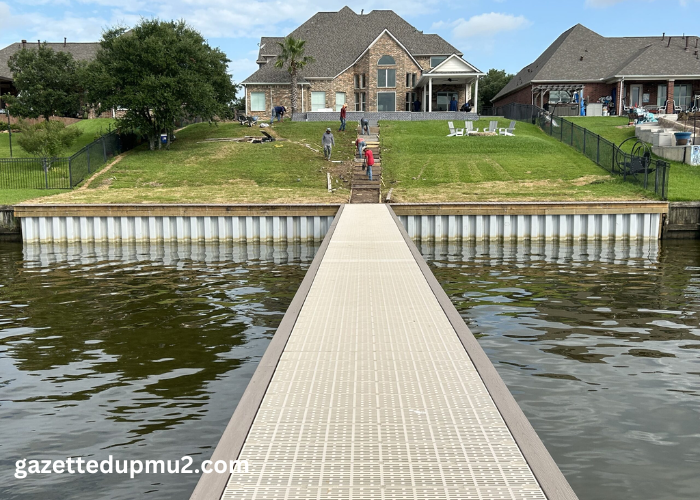Bulkhead erosion control is crucial for maintaining the integrity and functionality of docks and waterfront structures. As coastal areas face increasing pressures from natural and human activities, understanding the causes of bulkhead erosion and implementing effective solutions becomes essential. This post explores the various factors contributing to bulkhead erosion and offers practical solutions to mitigate its impact. By addressing both natural and human-induced causes, stakeholders can better protect their investments and ensure the longevity of their dock works.
Natural Causes
1. Tidal Action
Tidal action is a constant force that influences shorelines, creating a dynamic environment where water levels rise and fall regularly. As tides flow in and out, they exert pressure against bulkheads, causing materials to shift and erode over time. In areas with significant tidal ranges, this process can be particularly pronounced, leading to the gradual loss of soil and structural integrity. Additionally, as tides interact with currents, they can accelerate the erosion process, making it vital for bulkheads to be designed to withstand these repetitive forces.
2. Wave Energy
The energy of waves plays a crucial role in the erosion of bulkheads, especially in coastal regions exposed to open water. Wind-driven waves can generate considerable force, impacting bulkheads with great intensity, particularly during storms or severe weather events. This erosive power can displace soil and materials around the base of the bulkhead, undermining its support. The cumulative effect of wave action over time can lead to significant erosion, making it essential for bulkheads to incorporate design features that absorb and deflect wave energy.
3. Soil Saturation
Soil saturation is a critical factor contributing to bulkhead erosion. When heavy rainfall occurs, the soil surrounding a bulkhead can become saturated with water, increasing its weight and decreasing its cohesion. Saturated soils are more prone to slumping and erosion, especially in areas where bulkheads do not have adequate drainage. The saturation can also create hydrostatic pressure, pushing against the bulkhead and weakening its foundation. This condition makes it imperative for bulkhead designs to incorporate proper drainage systems that can manage water runoff and prevent soil saturation.
Human Factors
1. Construction Activities
The construction of docks, piers, and other waterfront structures can have a profound impact on local ecosystems and the stability of adjacent bulkheads. Excavation, grading, and filling activities can disrupt the natural sediment balance, leading to increased erosion around bulkheads. Moreover, heavy machinery used during construction can compact soils, reducing their ability to absorb water and increasing runoff. To mitigate these effects, it is essential to employ best practices during construction, including maintaining natural buffers and implementing silt fences to minimize sedimentation in water bodies.
2. Vessel Impacts
The movement of vessels near bulkheads poses a significant threat to their stability. The wakes generated by boats can create turbulent water conditions that strike the bulkhead with enough force to displace soil and cause erosion. Larger vessels, in particular, can generate substantial waves that impact the shoreline and erode the supporting soil. Additionally, groundings or improper docking can directly damage the bulkhead structure, further exacerbating erosion issues. To address this, regulations can be established to control vessel traffic and speed near sensitive areas, minimizing their impact on bulkhead integrity.
3. Poor Drainage
Inadequate drainage systems can significantly contribute to bulkhead erosion. When stormwater runoff is not effectively managed, water can accumulate around bulkheads, leading to soil saturation and increased pressure on the structure. Poor drainage can also direct water flow towards the bulkhead instead of away from it, heightening the risk of erosion. Implementing effective drainage solutions, such as catch basins, swales, and permeable surfaces, can help manage runoff and reduce the risk of bulkhead erosion. Proper drainage design is critical in maintaining the stability and longevity of waterfront structures.
Mitigation Solutions
1. Reinforced Bulkheads
Installing reinforced bulkheads is one of the most effective ways to enhance durability and resistance to erosive forces. Reinforced bulkheads are constructed using materials such as concrete, steel, or treated wood, which are designed to withstand high wave energy and tidal action. Additionally, incorporating design features such as battered slopes or fillets at the base can help distribute the force of waves more evenly, reducing localized erosion. Regular maintenance and inspections are also necessary to ensure that any signs of wear or damage are promptly addressed.
2. Vegetation Planting
Planting native vegetation along shorelines is a sustainable approach to stabilizing soils and reducing erosion. The roots of plants help anchor the soil, preventing it from being washed away during storms or high tides. Additionally, vegetation can act as a natural buffer, dissipating wave energy before it reaches the bulkhead. Selecting native plants that are well-adapted to local conditions can enhance the effectiveness of this strategy. Furthermore, vegetated areas provide habitat for wildlife and contribute to improved water quality by filtering runoff.
3. Erosion Control Fabrics
The use of erosion control fabrics offers a practical solution for protecting soils and preventing erosion. These materials, typically made from geotextiles, can be installed on the soil surface to create a barrier against erosive forces. They help retain soil while allowing water to drain, reducing the risk of saturation. Erosion control fabrics can also promote the establishment of vegetation by providing a stable substrate for plants to grow. This dual benefit enhances the overall effectiveness of bulkhead erosion control efforts.
Conclusion
Understanding bulkhead erosion and its causes is vital for effective bulkhead erosion control. By recognizing the natural and human factors that contribute to erosion, stakeholders can implement targeted solutions to protect their dock works. Whether through reinforced structures, strategic planting, or erosion control fabrics, proactive measures can mitigate the risks associated with erosion. For those involved in dock works, especially with companies like Charleston Dock Works, prioritizing these strategies will not only safeguard investments but also ensure the sustainability of waterfront areas for future generations. By adopting a comprehensive approach to bulkhead erosion control, the longevity and functionality of these vital structures can be preserved.





